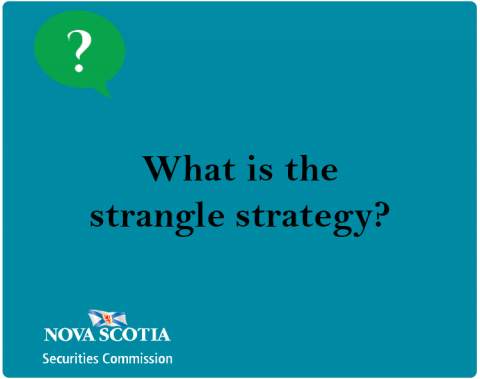Submitted by nsscadmin on

The term strangle strategy appeared in some local news articles recently and it led to a reader asking what exactly the strangle strategy is.
The Nova Scotia Securities Commission does not provide investment advice. We are not advising or recommending the use of options or any options strategy. This post is simply to educate investors on this strategy so they can be an informed investor when working with their adviser and making investment decisions.
Options trading entails a high amount risk and the use of leverage, and may not be suitable for you. You should consult with a registered investment advisor before considering any options trading or strategies.
The strangle strategy is an options strategy where the investor creates a position in a call and a put option at the same time with different strike prices, but with the same expiration date and the same underlying asset. When using the strangle strategy an investor is expecting volatility and a large price swing for the underlying asset, but they do not know if that large price swing will be up or down. The strangle may be profitable if this large price swing occurs.
On a long strangle(the more common type of strangle) an investor would simultaneously buy an out-of-the-money call option and an out-of-the-money put option. The call option’s price is higher than the asset’s current market price, while the put option is lower than the asset’s current market price. The investor may profit if the asset’s price has a large rise or a large fall. The investor is risking their premium paid for their options if one side of the strangle does rise in value.
Let’s look at an example to help clear up any confusion on how a long strangle works. Company X is currently trading at $100 per share. An investor expects a volatile change in the price of Company X, but is unsure if this change will be up or down, so they initiate a strangle.
They enter into a call option with a strike price of $115, and pay a premium of $5, which costs $500 for 100 shares ($5 x 100). They also enter into a put option with a strike price of $85, and pay a premium of $3, which costs $300 for 100 shares ($3 x 100). Both options have the same expiry date.
If the stock price of Company X stays between $85 and $115 during the lifespan of the option the investor may suffer a loss of $800, which is the cost of their call and put premiums. However, if the volatility they were expecting occurs, they could profit.
Let’s say the shares of Company X fall and end up at $70. Here the call option will expire out of the money and have a loss of $500. The put option may have gained in value. The drop from $115 to $70 is worth $45 per share, which is the put option’s intrinsic value, and since the investor has 100 shares that’s $4500. That isn’t all profit though. They must subtract the premiums paid which gives us a possible gain of$4500 - $500 -$300 = $3700.
What if the share price rises instead of falling? Let’s say Company X stock rises to $120. Here the put option expires out of the money and causes a loss of $300. The call option delivers a gain of $5 per share ($120 - $115) = $500 ($5x100) which is the call options intrinsic value. However, when we subtract the call and put premiums from the gain ($500 gain - $800 premiums) the result is a $300 loss.
This example describes a basic long strangle strategy, but there are other ways to initiate a strangle that are more complicated and carry more risk. Be sure you know exactly how options and a strangle work before agreeing to enter into a strangle.
As with any type of investment strategy the strangle strategy has risk. Before following any investment strategy be sure you fully understand it, and are sure it fits your risk tolerance and investment goals.
